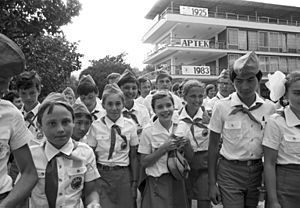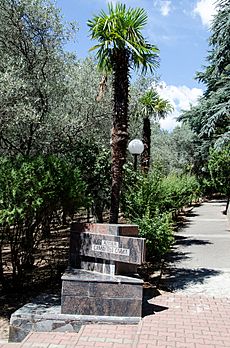Samantha Smith facts for kids
Quick facts for kids
Samantha Smith
|
|
|---|---|
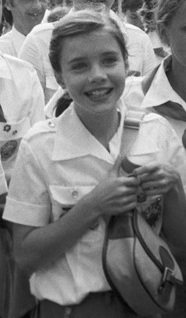
Smith visiting the Artek pioneer camp in July 1983
|
|
| Born |
Samantha Reed Smith
June 29, 1972 Houlton, Maine, U.S.
|
| Died | August 25, 1985 (aged 13) Auburn, Maine, U.S.
|
| Cause of death | Airplane crash |
| Resting place | Ashes buried at Estabrook Cemetery, Amity, Maine |
| Other names | America's Youngest Ambassador, America's Littlest Diplomat, America's Sweetheart (U.S.), The Goodwill Ambassador (USSR) |
| Occupation | Peace activist, child actress |
| Years active | 1982–1985 |
| Signature | |
 |
|
Samantha Reed Smith (June 29, 1972 – August 25, 1985) was an American peace activist and child actress. She became famous for her efforts during the Cold War between the United States and the Soviet Union. In 1982, Samantha wrote a letter to Yuri Andropov, the leader of the Soviet Union. She received a personal reply and an invitation to visit his country, which she accepted.
Samantha gained a lot of media attention as a "Goodwill Ambassador". People called her America's Youngest Ambassador. She later took part in peacemaking activities in Japan. With help from her father, Arthur, she wrote a book called Journey to the Soviet Union. This book was about her trip. She also became a child actress, hosting a special for The Disney Channel. She also co-starred in the TV series Lime Street. Samantha died at age 13 in an airplane crash on August 25, 1985.
Contents
A Time of Tension: The Cold War
When Yuri Andropov became the leader of the Soviet Union in November 1982, there was a lot of worry. Newspapers in Western countries often showed him in a negative way. This made people feel like he was a new threat. Andropov had been in charge of the KGB, a powerful Soviet security agency. He was known for being tough on people who disagreed with the government.
At this time, the United States and the Soviet Union were in the middle of the Cold War. This was a period of great tension and distrust. Both countries had many powerful weapons. They were also trying to develop new weapons that could be launched from space. Many people around the world were worried about a possible war. Large anti-nuclear protests were happening in Europe and North America. People wanted peace and for countries to get rid of their nuclear weapons.
On November 22, 1982, Time magazine featured Andropov on its cover. Samantha Smith saw this magazine. She asked her mother, "If people are so afraid of him, why doesn't someone write a letter asking whether he wants to have a war or not?" Her mother replied, "Why don't you?"
Samantha's Life and Her Famous Letter
Samantha Smith was born on June 29, 1972, in Houlton, Maine. Her parents were Jane Goshorn and Arthur Smith. When she was five, she even wrote a letter to Queen Elizabeth II to show her admiration. In 1980, her family moved to Manchester, Maine. Samantha attended Manchester Elementary School there. Her father taught at the University of Maine at Augusta. Her mother worked as a social worker.
Samantha wrote her letter to Yuri Andropov. She asked him if he was going to start a war. She also asked him what he thought about the Cold War. Her letter was published in Pravda, a major Soviet newspaper. Samantha was happy her letter was published, but she didn't get a reply right away. So, she wrote another letter to the Soviet ambassador in the U.S., Anatoly Dobrynin. She asked if Andropov planned to answer her.
A Trip for Peace
After her letter became famous, many news reporters wanted to talk to Samantha. She was interviewed by famous TV hosts like Ted Koppel and Johnny Carson. On July 7, 1983, Samantha and her parents flew to Moscow. They spent two weeks as guests of Yuri Andropov. During their trip, they visited Moscow and Leningrad. Samantha also spent time at Artek, a large Soviet youth camp in Gurzuf.
Samantha wrote in her book that people in Leningrad were very friendly. They gave her and her parents many gifts. At a press conference in Moscow, she said that Russians were "just like us." At Artek, Samantha chose to stay with the Soviet children. She didn't want special treatment. Teachers and children who spoke English helped her communicate. Samantha shared a room with nine other girls. She swam, talked, and learned Russian songs and dances. She made many friends, including Natasha Kashirina.
Andropov was too sick to meet Samantha in person. But they did talk on the phone. Samantha also got a call from Valentina Tereshkova, the first woman to orbit Earth. Samantha didn't realize who it was and hung up quickly! News media followed Samantha everywhere. She became very well-known in the Soviet Union. In the U.S., some people thought her trip was just a "public relations stunt" by the Soviets.
When Samantha returned to the U.S. on July 22, 1983, people in Maine welcomed her. Her popularity grew even more. Some critics still thought she was being used for Soviet propaganda. In December 1983, Samantha continued her role as "America's Youngest Ambassador." She was invited to Japan. There, she met Prime Minister Yasuhiro Nakasone. She also attended a Children's International Symposium in Kobe.
In her speech, Samantha suggested that leaders of the Soviet Union and America should exchange granddaughters. She thought they should visit each other's countries for two weeks each year. She said a president "wouldn't want to send a bomb to a country his granddaughter would be visiting." Her trip inspired other child goodwill exchanges. One example was Katya Lycheva, an 11-year-old Russian girl who visited the U.S. Samantha later wrote her book, Journey to the Soviet Union. The cover shows her at Artek, her favorite part of the trip.
Samantha's Acting Career
Samantha continued to be a media personality. In 1984, she hosted a children's special for The Disney Channel. It was called Samantha Smith Goes To Washington... Campaign '84. In this show, Samantha interviewed several candidates running for president. She also guest-starred in the TV show Charles in Charge. In 1985, she played a co-starring role in the TV series Lime Street. She played the older daughter of a character played by Robert Wagner.
Samantha's Tragic Death
On August 25, 1985, Samantha and her father were flying home. They were on Bar Harbor Airlines Flight 1808. They had just finished filming a part for Lime Street. The plane was trying to land at Lewiston-Auburn Regional Airport in Auburn, Maine. It hit some trees before reaching the runway and crashed. All six passengers and two crew members on board died.
There was a lot of talk about what caused the accident. Some people in the Soviet Union even thought it was foul play. But an investigation in the United States found no evidence of foul play. The official report said the plane crashed about a mile from the airport. It concluded that the way the plane hit the ground made it impossible for anyone to survive. The report also mentioned it was a rainy night. The pilots were not very experienced. And a ground radar system had a temporary failure.
About 1,000 people went to Samantha's funeral in Augusta, Maine. In Moscow, she was remembered as a champion of peace. Mikhail Gorbachev, the Soviet leader, sent a personal message of sadness. Samantha and her father were cremated. Their ashes were buried at Estabrook Cemetery in Amity, Maine.
Samantha's Lasting Legacy
Samantha Smith's efforts for peace have been honored in many ways. Especially in Russia and her home state of Maine. A monument to her was built in Moscow. "Samantha Smith Alley" at the Artek youth camp was named after her in 1986. In 2003, a new monument was built for her in Voronezh, Russia. The Soviet Union even made a commemorative stamp with her picture on it.
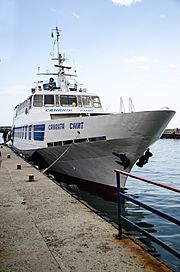
In 1986, a Russian astronomer named Lyudmila Chernykh discovered an asteroid. She named it 3147 Samantha in Samantha's honor. A diamond from Siberia, a mountain in the former Soviet Union, and types of tulips and dahlias were also named after her. Even an ocean vessel was named "Samantha Smith." In 1985, a peace garden was created in Michigan to remember her achievements.
In Maine, the first Monday in June is officially "Samantha Smith Day." There is a bronze statue of Samantha near the Maine State Museum in Augusta. It shows her releasing a dove, with a bear cub at her feet. The bear cub represents both Maine and Russia. Elementary schools in Sammamish, Washington, and Jamaica, Queens, New York City, are named after her.
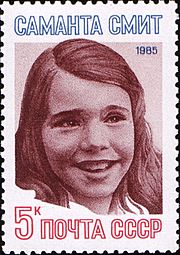
In 1985, Samantha's mother started The Samantha Smith Foundation. This foundation helped students from the U.S. and the Soviet Union (and later, former Soviet countries) exchange visits. The foundation helped build understanding between young people.
Samantha's story has inspired others. A 1987 episode of the TV show The Golden Girls was inspired by her. The 1987 film Superman IV: The Quest for Peace also had a scene inspired by Samantha's letter.
In 2008, Samantha received the Peace Abbey Courage of Conscience Award. This award recognized her for helping to improve understanding between the U.S. and the Soviet Union. Her actions helped reduce the tension between these two powerful countries.
See also
 In Spanish: Samantha Smith para niños
In Spanish: Samantha Smith para niños
- List of peace activists
- Sarah York, another American girl who wrote to a foreign political leader, in this case Manuel Noriega


